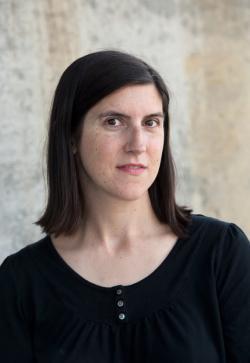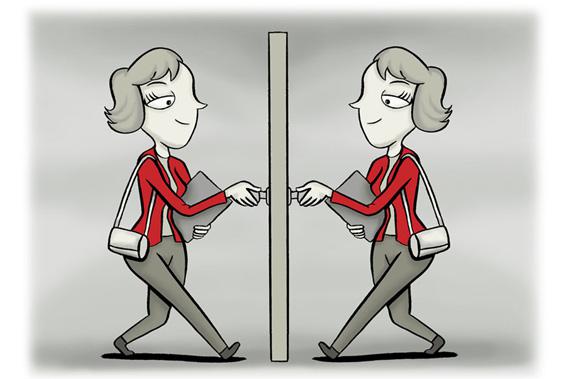One night when I was 14 I dreamt I was giving birth. The next morning, I got my period for the first time. I am not psychic—I realize there are rational explanations for what happened, the simplest being pure coincidence—but it was an odd moment, waking up, knowing something had changed. I remember a lot of details about the dream, like the dream-pain, which wasn’t real but still scared me. I don’t remember how many babies there were. I sort of suspect there were two.
I’m a twin. I’ve never not been a twin, which means I can’t tell you whether having a sibling your own age is overall fun or difficult, good or bad—for me it’s just the way it is. I’ve been a twin in many different and contradictory ways: a best friend to my sister, a bitter rival, supporting player, vivid example, even—painfully—a stranger. Katie Roiphe has written for Slate on the “dark side of sibling love,” tracing this passion’s volatility back to the fact that “the resources and embrace of the world” are ultimately unequal, that “the yellow lollipop is not the same as the red one.” But while my twin and I are different, Roiphe is wrong about why that difference matters. It’s not that the yellow lollipop is better than the red (any sibling worth her salt knows the mantra different doesn’t equal better). But as a twin (and I suspect as any sibling), you do end up surrendering huge swatches of your identity to someone who isn’t you.
That quality of losing control over your own reflection, and of reflecting someone else, doesn’t get a lot of play in the stories we tell about twinhood. Mostly we imagine shared jokes and secret languages, whispered conversations in bunk beds after Mom turns out the light. (Think The Parent Trap, It Takes Two, Fred and George Weasley, the Winklevii). The idea of an uncanny bond finds expression in the trope of psychic twins, which Curtis Sittenfeld brings to life in her shrewd new book Sisterland.
Yet Sittenfeld is acutely aware of how that bond can warp and fray—tellingly, her twins don’t read each other’s minds, but pick up on signals from the universe at large—and the novel ends up approaching sisterhood with the same delicate ambivalence it shows ESP. Both a gift and a burden, twinhood (like psychicness) means intimacy that is sometimes thrilling, sometimes unwanted.
Kate and Violet Schramm, who form the center of Sisterland, are a study in sensitivity gone awry. Despite their premonitions about the future, they excel at misunderstanding each other (though, of course, no one quite understands Kate the way Violet does, and vice versa). They live in St. Louis, where Kate is married to an aquatic chemistry professor at Washington University and Vi is a professional seer. While Kate, who narrates the book, wants only to live a normal suburban life with her husband and two small children, Vi is flamboyant and brash. When tremors hit St. Louis, she goes on Today prophesying a much larger earthquake. The novel follows the aftershocks of that TV appearance, as a horrified Kate tries to perform damage control, though—haunted by stray apprehensions of her own—she half-believes Vi is right.
The novel shuttles back and forth between the present day, in which Kate cultivates a friendship with a stay-at-home father named Hank and weathers the storm from Vi’s prediction, and scenes from the Schramms’ adolescence. Sittenfeld could have plucked these recollected episodes from some universal sibling memory album: the popular high school girl who invites one twin to her sleepover party but not the other (never, ever OK); the sign adorning the bedroom door (the Schramms’ says, “Sisterland: Population 2.” Ours said, “Do not enter if you aren’t Emmy/Katy.”). And she expertly draws out the rivalries and provocations that make every sibling exchange a coded mini-drama. After a party, Kate reports, “I left reeking of cigarette smoke, much of it directed at me by my sister.” Naturally. And yet the narrator, like so many of us, yearns for the tethers that come with having another half. Later, she startles at “the shocking weightlessness of being responsible only for myself.” Divorcing your twin is the loneliest thing, like suffering from an existential phantom limb syndrome.
The third person in the room, of course, is Sittenfeld herself, who brings to Sisterland the same perceptive, no-frills lucidity she gave Prep, Man of My Dreams, and American Wife. She is an attractive writer, though not a beautiful one, with a chatty, thoughtful, somehow elusive voice—like that of a wise but preoccupied friend. What she doesn’t say crowds behind what she does. And she is funny. “I heard myself say to Ben, ‘I’m going to compost the rest of the bok choy,’ ” Kate reveals at one point, “and pretty much everything I was smug about then was encapsulated in that single sentence.”

Photo courtesy of Josephine Sittenfeld
On a scale of witticisms about bok choy to whimsy, Sittenfeld goes for the leafy green every time. She is not interested in fanciful cutesiness, but rather in the push and pull of the sisters’ connection, the alternating dance of irritation and appeasement, antagonism and loyalty. “For more than half my life, I’d been laying the groundwork for my own invisibility,” says Kate, “for far longer, in fact, than Vi had been laying the groundwork for her exposure.” But both sisters spend the novel painstakingly inventing themselves in opposition to each other. Tempting though it is to follow their lead and go into pigeon-holing mode—Kate is “the conventional one,” Violet is “the free spirit”; Kate is thin, Violet is overweight—the book resists this familiar way of understanding twins. Carefully, it explores the constructedness of the two women’s identities. “Even at her most impossible, Vi had never said or done anything I could not imagine saying or doing myself, if I had less self-control and respect for convention,” Kate admits.
And so Sisterland flirts with and then moves past our sense of twins as either interchangeable or incomplete, extraneously duplicate or two halves of a whole. If only naming the problem of distinct individuals, inextricably linked, solved it. When Violet comes unannounced to visit Kate at college, Kate says, “Her hand reaching for the doorknob as we left the room, cuffed by the red fleece of my jacket—it could have been my hand, there was a way in which it was my hand.” Yes, murmur the siblings of the world, that is exactly how it is. In harmlessly being herself, Vi is also usurping her sister’s identity. Such coups form the fabric of sibling life. Let your twin be “smart.” Now, you are suddenly “smart” too—or, conversely, “the dumb one.”
One last thing you should know about twins: It all comes down to math. Your twin equals you, equals not-you. X plus Y (variables of supposedly equal value) add up to 1, or is it 2? To say twins are opposites is as bad as saying they are the same, implying as it does that together, they constitute a well-rounded person (0?). Does it insult my twin that I view her as a projection of myself? Yes and no (because she is) (because she does it to me). If you think all of this sounds hopelessly convoluted, you’re right. The hall of mirrors extends infinitely, in both directions. But at least I don’t have to figure it out alone.
—
Sisterland by Curtis Sittenfeld. Random House.
See all the pieces in this month’s Slate Book Review.
Sign up for the Slate Book Review monthly newsletter.
